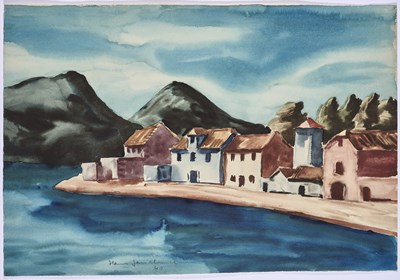20th Mar, 2024 12:00
From the Studio: Works from 15 Artists' Estates
52
⊕ HANS GASSEBNER (GERMAN 1902-1966)
Hans Gassebner (lots 52-59)
Introduction
Born in southern Germany between Stuttgart and Munich, Gassebner's mother died when he was young, and he grew up in penurious circumstances. He attended school in Blaubeuren, before completing his studies in Stuttgart. One of his first jobs was as an optician's assistant after which, in his early twenties, he briefly studied Arts and Crafts in Darmstadt. But unable to afford the course he took a job as an assistant nurse in the near by Alzey psychiatric hospital, and developed his art in his free time.
In 1923 Gassebner visited Vienna, where he met artists in the Nötsch circle, a loose community of painters including Anton Kolig and Sebastian Isepp associated with Nötsch in southern Austria. Kolig subsequently invited Gassebner to Nötsch in 1929, where he met Anton Mahringer. The two became friends, Gassebner settled for a period near Nötsch and he and Mahringer travelled together to Dalmatia, Yugoslavia in 1934 (lots 54 & 55). After Gassebner's work was branded Degenerate by the Nazis, he quit Germany with his Jewish partner to escape persecution, not returning until after the War. Gassebner’s early works are of a dark and melancholic quality, reflecting the oppressive mood in Germany at the time. On their travels the couple explored Austria, Italy, Yugoslavia and Greece and Gassebner developed his print making.
Gassebner suffered from pains in his right hand throughout his life, and a deadly thorotrast injection in 1938, would lead to long-term suffering, ending in a medical malpractice lawsuit, burdening Gassebner financially for his final years, and limiting his artistic practice. Despite the hardships, his later works depict picturesque landscapes in brighter colour palettes, emulating the work of Cézanne and van Gogh, and reflect the end of the war.
During his lifetime Gassebner exhibited with Albert Burkart, Alfred Wais and Carl Pflüger in the 1948 Watercolours of Upper Swabian Painters. Following his death, the Fähre Gallery in Bad Saulgau, Germany acquired most of the estate and would go on to have two commemorative exhibitions, marking his 75th and 100th birthdays in 1977 and 2002 respectively.
52
HANS GASSEBNER (GERMAN 1902-1966)
THE QUAY, ZATON MALI, YUGOSLAVIA
signed and dated Hans Gassebner 47 lower centre
watercolour over pencil on paper
26.5 x 39cm;10 3/4 x 15 1/4in
(unframed)
Offered together with a monotype by the same hand of a coastal landscape.
(2)
Zaton Mali is on the Adriatic coast, Croatia, which was part of Yugoslavia between 1918 and 1992.
Hans Gassebner (lots 52-59)
Introduction
Born in southern Germany between Stuttgart and Munich, Gassebner's mother died when he was young, and he grew up in penurious circumstances. He attended school in Blaubeuren, before completing his studies in Stuttgart. One of his first jobs was as an optician's assistant after which, in his early twenties, he briefly studied Arts and Crafts in Darmstadt. But unable to afford the course he took a job as an assistant nurse in the near by Alzey psychiatric hospital, and developed his art in his free time.
In 1923 Gassebner visited Vienna, where he met artists in the Nötsch circle, a loose community of painters including Anton Kolig and Sebastian Isepp associated with Nötsch in southern Austria. Kolig subsequently invited Gassebner to Nötsch in 1929, where he met Anton Mahringer. The two became friends, Gassebner settled for a period near Nötsch and he and Mahringer travelled together to Dalmatia, Yugoslavia in 1934 (lots 54 & 55). After Gassebner's work was branded Degenerate by the Nazis, he quit Germany with his Jewish partner to escape persecution, not returning until after the War. Gassebner’s early works are of a dark and melancholic quality, reflecting the oppressive mood in Germany at the time. On their travels the couple explored Austria, Italy, Yugoslavia and Greece and Gassebner developed his print making.
Gassebner suffered from pains in his right hand throughout his life, and a deadly thorotrast injection in 1938, would lead to long-term suffering, ending in a medical malpractice lawsuit, burdening Gassebner financially for his final years, and limiting his artistic practice. Despite the hardships, his later works depict picturesque landscapes in brighter colour palettes, emulating the work of Cézanne and van Gogh, and reflect the end of the war.
During his lifetime Gassebner exhibited with Albert Burkart, Alfred Wais and Carl Pflüger in the 1948 Watercolours of Upper Swabian Painters. Following his death, the Fähre Gallery in Bad Saulgau, Germany acquired most of the estate and would go on to have two commemorative exhibitions, marking his 75th and 100th birthdays in 1977 and 2002 respectively.
52
HANS GASSEBNER (GERMAN 1902-1966)
THE QUAY, ZATON MALI, YUGOSLAVIA
signed and dated Hans Gassebner 47 lower centre
watercolour over pencil on paper
26.5 x 39cm;10 3/4 x 15 1/4in
(unframed)
Offered together with a monotype by the same hand of a coastal landscape.
(2)
Zaton Mali is on the Adriatic coast, Croatia, which was part of Yugoslavia between 1918 and 1992.
Auction: From the Studio: Works from 15 Artists' Estates, 20th Mar, 2024
Auction to start at 12 noon
Viewing
PUBLIC EXHIBITION
Sunday 17th March 12:00pm - 4:00pm
Monday 18th March 10:00am - 8:00pm
Tuesday 19th March 10:00am - 5:00pm


